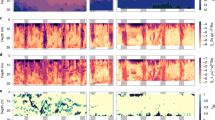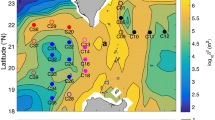Abstract
Recent observations of biologically generated turbulence in the ocean have led to conflicting conclusions regarding the significance of the contribution of animal swimming to ocean mixing. Measurements indicate elevated turbulent dissipation—comparable with levels caused by winds and tides—in the vicinity of large populations of planktonic animals swimming together1. However, it has also been noted that elevated turbulent dissipation is by itself insufficient proof of substantial biogenic mixing, because much of the turbulent kinetic energy of small animals is injected below the Ozmidov buoyancy length scale, where it is primarily dissipated as heat by the fluid viscosity before it can affect ocean mixing2. Ongoing debate regarding biogenic mixing has focused on comparisons between animal wake turbulence and ocean turbulence3,4. Here, we show that a second, previously neglected mechanism of fluid mixing—first described over 50 years ago by Charles Darwin5— is the dominant mechanism of mixing by swimming animals. The efficiency of mixing by Darwin’s mechanism is dependent on animal shape rather than fluid length scale and, unlike turbulent wake mixing, is enhanced by fluid viscosity. Therefore, it provides a means of biogenic mixing that can be equally effective in small zooplankton and large mammals. A theoretical model for the relative contributions of Darwinian mixing and turbulent wake mixing is created and validated by in situ field measurements of swimming jellyfish using a newly developed scuba-based laser velocimetry device6. Extrapolation of these results to other animals is straightforward given knowledge of the animal shape and orientation during vertical migration. On the basis of calculations of a broad range of aquatic animal species, we conclude that biogenic mixing via Darwin’s mechanism can be a significant contributor to ocean mixing and nutrient transport.
This is a preview of subscription content, access via your institution
Access options
Subscribe to this journal
Receive 51 print issues and online access
$199.00 per year
only $3.90 per issue
Buy this article
- Purchase on Springer Link
- Instant access to full article PDF
Prices may be subject to local taxes which are calculated during checkout



Similar content being viewed by others
References
Kunze, E., Dower, J. F., Beveridge, I., Dewey, R. & Bartlett, K. P. Observations of biologically generated turbulence in a coastal inlet. Science 313, 1768–1770 (2006)
Visser, A. W. Biomixing of the oceans? Science 316, 838–839 (2007)
Huntley, M. E. & Zhou, M. Influence of animals on turbulence in the sea. Mar. Ecol. Prog. Ser. 273, 65–79 (2004)
Dewar, W. K. et al. Does the marine biosphere mix the ocean? J. Mar. Res. 64, 541–561 (2006)
Darwin, C. Note on hydrodynamics. Proc. Camb. Phil. Soc. Biol. Sci. 49, 342–354 (1953)
Katija, K. & Dabiri, J. O. In situ field measurements of aquatic animal-fluid interactions using a self-contained underwater velocimetry apparatus (SCUVA). Limnol. Oceanogr. Methods 6, 162–171 (2008)
Eckart, C. An analysis of the stirring and mixing process in incompressible fluids. J. Mar. Res. 7, 265–275 (1948)
Eames, I. & Bush, J. W. M. Longitudinal dispersion of bodies fixed in a potential flow. Proc. R. Soc. Lond. A 455, 3665–3686 (1999)
Thorpe, S. A. The Turbulent Ocean (Cambridge Univ. Press, 2005)
Tennekes, H. & Lumley, J. L. A First Course in Turbulence (The MIT Press, 1972)
Eames, I. The concept of drift and its application to multiphase and multibody problems. Phil. Trans. R. Soc. Lond. A 361, 2951–2965 (2003)
Dabiri, J. O. Note on the induced Lagrangian drift and added-mass of a vortex. J. Fluid Mech. 547, 105–113 (2006)
Eames, I., Gobby, D. & Dalziel, S. B. Fluid displacement by Stokes flow past a spherical droplet. J. Fluid Mech. 485, 67–85 (2003)
Lamb, H. Hydrodynamics 6th edn (Cambridge Univ. Press, 1993)
Hamner, W. M., Gilmer, R. W. & Hamner, P. P. The physical, chemical, and biological characteristics of a stratified, saline, sulfide lake in Palau. Limnol. Oceanogr. 27, 896–909 (1982)
Fish, F. E. Comparative kinematics and hydrodynamics of odontocele cetaceans: morphological and ecological correlates with swimming performance. J. Exp. Biol. 201, 2867–2877 (1998)
Parrish, J. K., Viscido, S. V. & Grunbaum, D. Self-organized fish school: an examination of emergent properties. Biol. Bull. 202, 296–305 (2002)
Turner, J. S. The flow into an expanding spherical vortex. J. Fluid Mech. 18, 195–208 (1964)
Eames, I., Belcher, S. E. & Hunt, J. C. R. Drift, partial drift and Darwin’s proposition. J. Fluid Mech. 275, 201–223 (1994)
Willert, C. E. & Gharib, M. Digital particle image velocimetry. Exp. Fluids 10, 181–193 (1991)
Acknowledgements
We acknowledge W. M. Graham, J. H. Costello and H. Swift for assistance in field measurements and M. Schaadt for preparatory dive assistance. Additional logistical support was provided by the Coral Reef Research Foundation. Field work in Palau was supported by the National Science Foundation Biological Oceanography Program (to M. N. Dawson and J.O.D.). Additional support (to J.O.D.) from NSF Biological Oceanography, Ocean Technology, Fluid Dynamics, and Energy for Sustainability and from the Office of Naval Research (K.-H. Kim) is acknowledged, as are NSF and NDSEG fellowships (to K.K.) and the Charles Lee Powell Foundation.
Author Contributions K.K. and J.O.D. designed the study, analysed the data and wrote the manuscript. K.K. performed the experiments and viscous flow simulations. J.O.D. performed the inviscid flow simulations and derivation of equation (1).
Author information
Authors and Affiliations
Corresponding authors
Supplementary information
Supplementary Figure
This file contains Supplementary Figure S1 with Legend. (PDF 65 kb)
Supplementary Movie 1
This animated movie file shows the computed fluid drift induced by the vertical passage of a sphere. Trajectories of individual fluid particles are indicated. (MPG 2057 kb)
Supplementary Movie 2
This animated movie file shows the computed fluid drift induced by the vertical passage of a sphere. Vertical (only) drift of the horizontal layer defined by the fluid particles is indicated. (MPG 2077 kb)
Supplementary Movie 3
This movie file shows a 5-cm Mastigias sp. jellyfish swimming through a patch of dye injected upstream. Region of forward-drifting dye induced by jellyfish motion is apparent immediately behind the animal. (MPG 1831 kb)
Supplementary Movie 4
This movie file shows a 8-cm Mastigias sp. jellyfish swimming through a patch of dye injected upstream. Region of forward-drifting dye induced by jellyfish motion is apparent immediately behind the animal. (MPG 1565 kb)
Supplementary Movie 5
This movie file shows a Mastigias sp. jellyfish swimming through a dye-labelled density stratification. (MPG 1544 kb)
Rights and permissions
About this article
Cite this article
Katija, K., Dabiri, J. A viscosity-enhanced mechanism for biogenic ocean mixing. Nature 460, 624–626 (2009). https://doi.org/10.1038/nature08207
Received:
Accepted:
Issue Date:
DOI: https://doi.org/10.1038/nature08207
This article is cited by
-
The fate of salp blooms: decomposition and sinking of salp carcasses
Marine Biology (2024)
-
The Three Dimensional Spatial Structure of Antarctic Krill Schools in the Laboratory
Scientific Reports (2019)
-
Multi-functional soft-bodied jellyfish-like swimming
Nature Communications (2019)
-
Vertically migrating swimmers generate aggregation-scale eddies in a stratified column
Nature (2018)
-
Drift due to two obstacles in different arrangements
Theoretical and Computational Fluid Dynamics (2016)
Comments
By submitting a comment you agree to abide by our Terms and Community Guidelines. If you find something abusive or that does not comply with our terms or guidelines please flag it as inappropriate.



